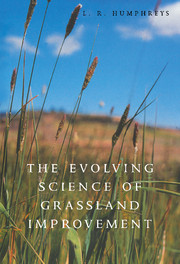Book contents
- Frontmatter
- Contents
- Preface
- Acknowledgements
- Abbreviations
- 1 Grassland improvement and environmental protection
- 2 The plant genetic base for grassland improvement
- 3 The nitrogen economy of grasslands
- 4 Growth and defoliation
- 5 Grassland ecology
- 6 Grazing management
- 7 Innovation, optimization and the realization of change
- Appendix The International Grassland Congresses
- References
- Index
1 - Grassland improvement and environmental protection
Published online by Cambridge University Press: 19 September 2009
- Frontmatter
- Contents
- Preface
- Acknowledgements
- Abbreviations
- 1 Grassland improvement and environmental protection
- 2 The plant genetic base for grassland improvement
- 3 The nitrogen economy of grasslands
- 4 Growth and defoliation
- 5 Grassland ecology
- 6 Grazing management
- 7 Innovation, optimization and the realization of change
- Appendix The International Grassland Congresses
- References
- Index
Summary
The science of grassland improvement
Grassland occupies c. 25% of the global land surface (Mooney, 1993) and is central to human welfare. Our understanding of the functioning of grassland and the ways in which it may be modified to meet particular objectives has evolved discontinuously during the last 60 years as scientists made imaginative leaps in grasping the processes at work, validated their insights (or not), and altered the directions of their research in response to inputs from farmers, societal pressures and changing fashion. A good benchmark is Stapledon (1933). This book selectively reviews aspects of the subsequent evolution and forecasts future directions.
Grassland ‘improvement’ denotes an advance upon a previous condition. An advance may refer to increased efficiency of production, which has been a dominant theme at all of the International Grassland Congresses since the first was held in 1927; it has been balanced by other emerging emphases in recent decades, such as the conservation of resources and the reduction of off-farm effects of agricultural development. Grassland improvement is a necessary objective for native rangelands, of which c. 75% in Africa, South America and Asia and c. 55% in Australia are regarded as ‘degraded’ (UNEP, 1991). The concept of grassland improvement has come to reflect wider metaphors of agriculture (McClintock & Ison, 1994) which include countryside design, and ‘Every landscape has an equally appropriate use, given a different set of values’ (Foran, 1993).
- Type
- Chapter
- Information
- The Evolving Science of Grassland Improvement , pp. 1 - 28Publisher: Cambridge University PressPrint publication year: 1997



